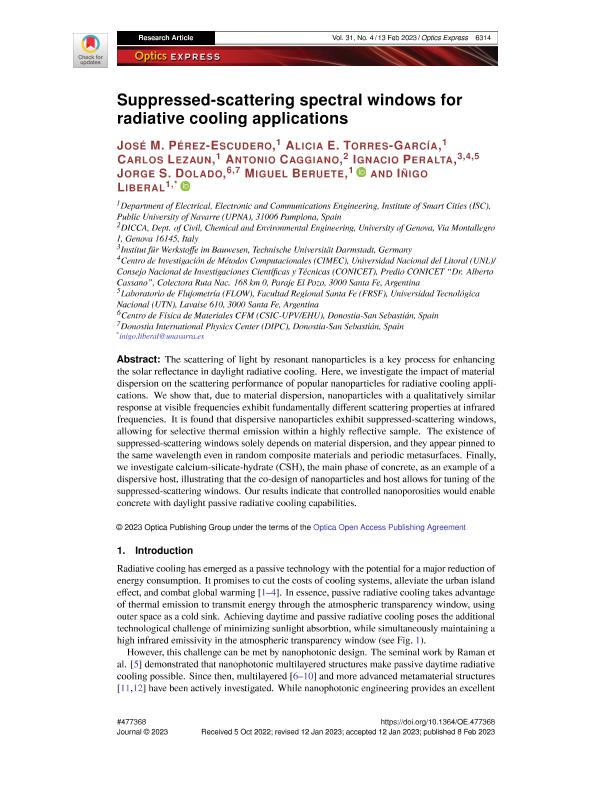Artículo
Suppressed-scattering spectral windows for radiative cooling applications
Pérez Escudero, José M.; Torres García, Alicia E.; Lezaun, Carlos; Caggiano, Antonio; Peralta, Ignacio ; Dolado, Jorge S.; Beruete, Miguel; Liberal, Iñigo
; Dolado, Jorge S.; Beruete, Miguel; Liberal, Iñigo
 ; Dolado, Jorge S.; Beruete, Miguel; Liberal, Iñigo
; Dolado, Jorge S.; Beruete, Miguel; Liberal, Iñigo
Fecha de publicación:
02/2023
Editorial:
Optical Society of America
Revista:
Optics Express
ISSN:
1094-4087
Idioma:
Inglés
Tipo de recurso:
Artículo publicado
Clasificación temática:
Resumen
The scattering of light by resonant nanoparticles is a key process for enhancing the solar reflectance in daylight radiative cooling. Here, we investigate the impact of material dispersion on the scattering performance of popular nanoparticles for radiative cooling applications. We show that, due to material dispersion, nanoparticles with a qualitatively similar response at visible frequencies exhibit fundamentally different scattering properties at infrared frequencies. It is found that dispersive nanoparticles exhibit suppressed-scattering windows, allowing for selective thermal emission within a highly reflective sample. The existence of suppressed-scattering windows solely depends on material dispersion, and they appear pinned to the same wavelength even in random composite materials and periodic metasurfaces. Finally, we investigate calcium-silicate-hydrate (CSH), the main phase of concrete, as an example of a dispersive host, illustrating that the co-design of nanoparticles and host allows for tuning of the suppressed-scattering windows. Our results indicate that controlled nanoporosities would enable concrete with daylight passive radiative cooling capabilities.
Palabras clave:
Radiative cooling
,
Nanoparticles
,
Concrete
Archivos asociados
Licencia
Identificadores
Colecciones
Articulos(CIMEC)
Articulos de CENTRO DE INVESTIGACION DE METODOS COMPUTACIONALES
Articulos de CENTRO DE INVESTIGACION DE METODOS COMPUTACIONALES
Citación
Pérez Escudero, José M.; Torres García, Alicia E.; Lezaun, Carlos; Caggiano, Antonio; Peralta, Ignacio; et al.; Suppressed-scattering spectral windows for radiative cooling applications; Optical Society of America; Optics Express; 31; 4; 2-2023; 6314-6326
Compartir
Altmétricas



